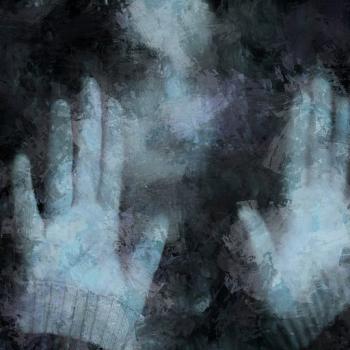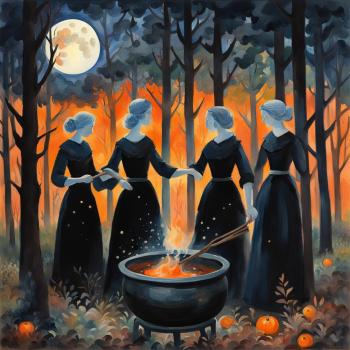Though ancient beyond belief and occurring in indigenous iconographies all over the world, the Pentagram has become the symbol of magic and Witchcraft. A five-pointed star enclosed within a circle, it is used for invocation, banishing, protection, and as a recognition symbol. Witches will often have a small Pentagram about them, just as Christians will wear a cross on a necklace or lapel pin; for the sense of security it gives them, as a reminder to be conscious of who and what they are, and so other Witches may know them for kin.
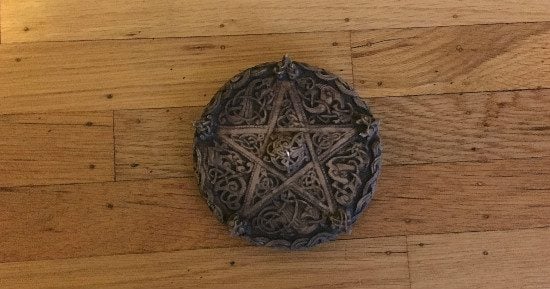
The Pentagram has more meanings than any other symbol in Wiccan iconography. It means perfection, evolution, working to completion, and is a glyph of the way energy moves between the Godhead and humanity and back again. It symbolizes the five physical senses with the spirit at the center; different forms of it represent each of the four magical elements while one form represents all four elements with spirit either at the top or bottom; it also represents motion of the Universe, weaving itself within a place of perfect stillness.
In ritual magic, the symbolism of the Pentagram has been elaborated until it is possible to make it the object of lengthy meditations, and to make entire devotional phrases in Hebrew (in which language every letter has a numerical value, which in turn has an esoteric meaning) out of the proportions of the line segments. As these meditations deal almost entirely with that Deity represented by the Tetragrammaton, further detail is outside my scope here. Nonetheless, it is interesting to Witches to read some of the materials these traditions have generated on the subject, and can enrich our understanding of the meanings and uses of the Pentagram.
There are two primary variations on the Pentagram, as used by Wicca. These are the Banishing and Invoking Pentagram, and the difference between them is merely a matter of the starting point and direction of line used when drawing. (Please note that when drawing on paper the star is always enclosed in the circle, while when drawing in the air or assuming the Pentacle position, the Circle is implied.)
The Banishing Pentagram is used in protection and as an exorcism. It is drawn beginning at the lower left “leg” and moving up to the top point, then clockwise around the rest of the star. If the circle is being drawn it is begun at the beginning/ending point of the star, ideally without lifting the pencil.
The Invoking Pentagram is used, obviously, in invocation and blessing. It is drawn beginning at the top and moving down to the left “leg”, then around counter-clockwise. Usually, when “the Pentagram” is referred to without elaboration, the invoking Pentagram is meant.
An interesting thing about these Pentagrams is that they are drawn backwards from the usual direction taken in invocation and banishing. Movement deosil, or clockwise, is generally considered to be constructive and invocational; movement widdershins (counter-clockwise) is considered destructive or negational. Yet the Invoking Pentagram is drawn with a counter-clockwise stroke, the Banishing Pentagram with a clockwise one – as seen by the person drawing them. In meditating on this oddity, I came to the conclusion that as seen by a person or entity on the other side of the Pentagram (at whom, presumably, it is being drawn) it is consistent with general magical practice. As with all things Wiccan, your mileage may vary.
The Pentagram entered Christian mythology from paleo- paganismon many levels: As “Solomon’s Seal” the Pentagram was believed to be the symbol used by that Biblical monarch to bind demons and djinni to his will and, hence, was considered the protective talisman par excellence. As such, it was often inscribed on knights’ shields to protect them in battle; both Arthur and Gawain are described as bearing shields with that device.
In historical times, the five-petaled Tudor rose was a thinly-disguised pentagram, as seen by the points of the sepals rising behind the petals themselves. This rose, by the way, is a symbol not only of the house of Tudor (or Twdyr) but of the God Mars.

The Star of Bethlehem is also traditionally depicted with five points, probably to distinguish it from the Star of David, or hexagram. The way in which the Pentagram could be endlessly traced without lifting the pencil, crossing and interweaving over and under itself, gave it the name of the “Endless Knot”.
Almost everyone has seen the drawing, attributed to Leonardo DaVinci, of a (male) human body superimposed on/in a Pentagram. His hands extend into the horizontal points, his feet into the two lower points, and his head is in the upper one. This has been called “Man Perfected” or “Vitruvian Man,” and is a symbol of the microcosm (man) united with the macrocosm (the Universe, represented by the Pentagram). The pose of the man in the Pentagram is one of the two major ritual postures used in Craft workings, the other being the “Osiris Position”.
The Osiris position is closed; the feet are together and the arms are crossed with the hands resting on opposite shoulders (of if holding tools, with the tools at shoulder level). It represents death-and-rebirth as one thing, and that which we living cannot know about it. It is a position of power in potentiality, or contained.
The Pentagram position is open; the arms are held horizontal and to the sides at shoulder level, the feet are apart and braced. From this position many other positions and movements may derive. It is a position of power being manifested in the physical realms and of the conscious identification of the Witch with the macrocosm. In ritual, the Witch always assumes the Pentagram position for a moment before performing either the invoking or banishing pentagram, and often holds it while speaking certain invocations or spells.
So far I’ve spoken only of the upright Pentagram, but there’s another form, with the point down. For years now, the inverted Pentagram, along with the inverted Christian cross, has been seen primarily as a symbol of organized satanism. Thanks a lot, 80s heavy metal bands. Originally, the inverted position was a form of the banishing Pentagram; it also represents the dark of the Moon and in some traditions is the sigil of one of the initiatory degrees. In Christian iconography it used to sometimes represent the light of God pouring from Heaven via the downward point onto believers below.
But where did it originate?
The pentagram, according to numerous books and websites, can be plotted by charting the synodic period of the planet Venus. A synodic period is the time it takes a planet, as viewed from Earth, to circle us. Venus’ synodic period is 584 days. In eight years and one day, it completes five synodic periods and returns to its starting place against the Zodiac.
At the point closest to Earth, or the inferior conjunction, during each synodic period, Venus appears to go retrograde – move backwards relative to us as she swings back out into the larger orbit; the path, as shown below, looks like a small loop in the orbit. And each synodic period is about 72° off from the previous, due to the precession of Venus’ orbit relative to ours. If you make a dot on a zodiac wheel or star map at each inferior conjunction between Earth and Venus, and then connect them in the order in which they were created – dot 1 to dot 2, dot 2 to dot 3, and so on, you draw not a pentagon but a pentagram.
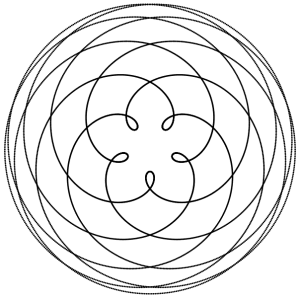
There is a lot of conjecture, though no solid proof, that the Venus Pentagram has been observed and given significance since earliest times, and that it is the reason for pentagrams appearing incised on the walls of humanity’s earliest structures – and has been with us ever since.
There is something about the Pentagram which has caught at the imaginations of human beings for centuries. Witch and Christian alike, at one time or another, have tried to unravel the Endless Knot, and it has led them a merry dance through the region of the Stars. It evokes a sense of wonder, of standing on the brink of some vast and marvelous new understanding.
A simple glyph of a star of five points enclosed within a circle, and it glows within the mind: perfect, beautiful, numinous. Why this should be so, I cannot say. Yet there are those of us who, rather than adopting the Pentagram because we had come into the Craft, came into the Craft to unravel the eternal riddle of the Pentagram.

Patheos Pagan on Facebook.
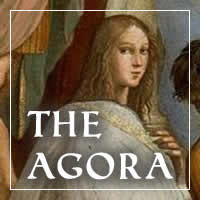
the Agora on Facebook
The Rantin’ Raven is published on alternate Saturdays here on the Agora. Subscribe via RSS or e-mail!
Please use the links to the right to keep on top of activities here on the Agora as well as across the entire Patheos Pagan channel.









